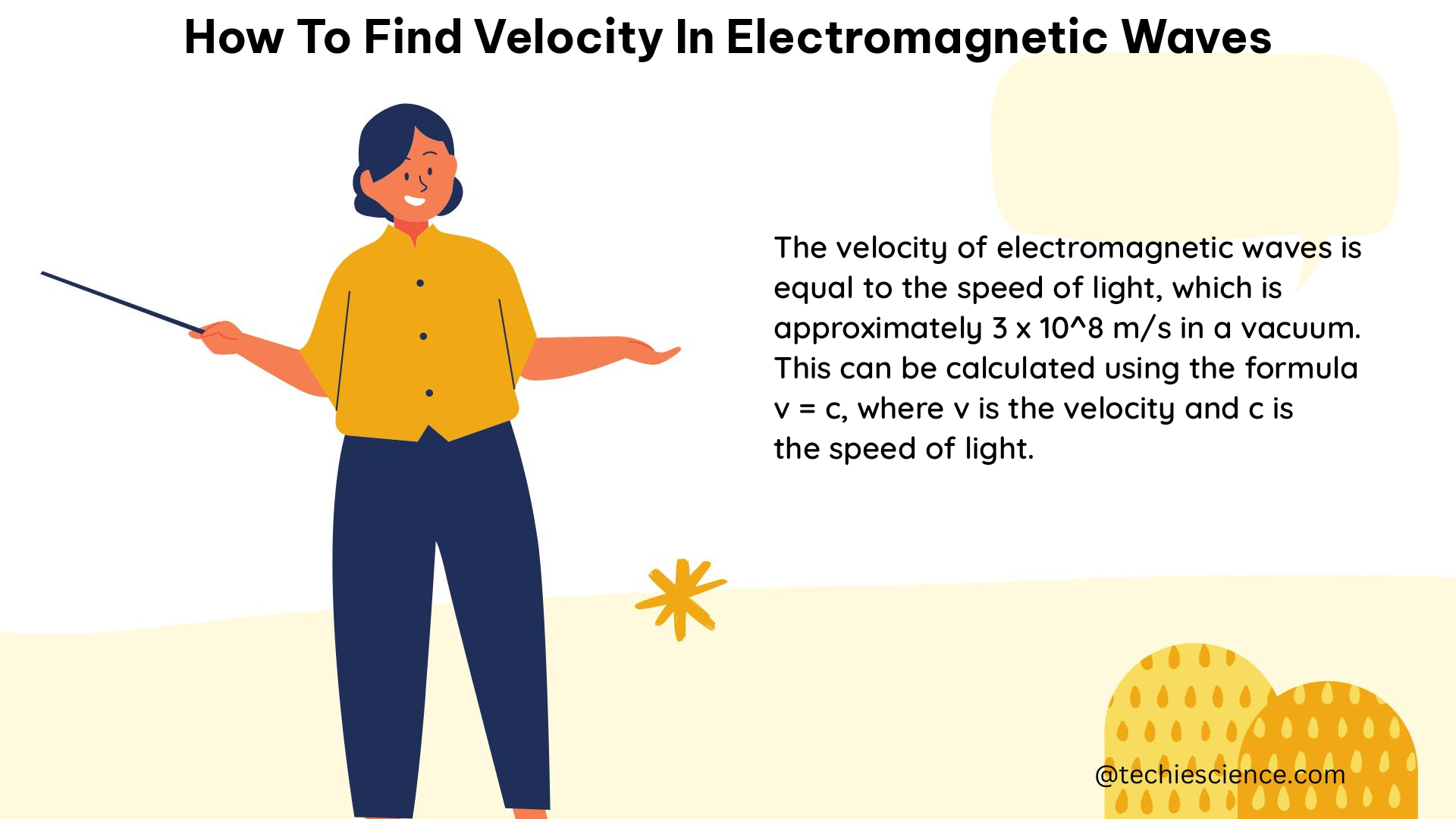Electromagnetic waves, such as visible light, radio waves, and X-rays, are fundamental to our understanding of the physical world. Determining the velocity of these waves is crucial for various applications, from telecommunications to medical imaging. In this comprehensive guide, we will delve into the intricacies of calculating the velocity of electromagnetic waves, providing you with a thorough understanding of the underlying principles and practical applications.
Understanding the Fundamentals of Electromagnetic Waves
Electromagnetic waves are a type of transverse wave that propagate through space and time, carrying energy in the form of electric and magnetic fields. These waves are characterized by their wavelength, frequency, and velocity, which are related by the equation:
v = λ × f
where v is the velocity of the wave, λ is the wavelength, and f is the frequency.
The velocity of an electromagnetic wave in a vacuum is a fundamental constant, known as the speed of light, denoted as c. This value is approximately 299,792,458 meters per second (m/s) or 186,282 miles per second (mi/s).
Calculating Velocity Using the Index of Refraction

When an electromagnetic wave travels through a medium, such as air, water, or glass, its velocity is affected by the properties of the medium. The relationship between the velocity of the wave in the medium (v) and the speed of light in a vacuum (c) is given by the index of refraction (n):
v = c / n
The index of refraction is a dimensionless quantity that represents the ratio of the speed of light in a vacuum to the speed of light in the medium. It is a measure of how much the speed of light is reduced when it travels through a particular medium.
Determining the Index of Refraction
The index of refraction of a medium can be determined experimentally or found in reference tables. Here are some common values for the index of refraction:
| Medium | Index of Refraction (n) |
|---|---|
| Vacuum | 1.0000 |
| Air (at standard temperature and pressure) | 1.0003 |
| Water | 1.3330 |
| Glass (typical) | 1.5 to 1.9 |
| Diamond | 2.4200 |
These values can vary slightly depending on the specific wavelength of the electromagnetic wave and the temperature and pressure of the medium.
Calculating Velocity Using the Index of Refraction
Once you have the index of refraction for a given medium, you can use the formula v = c / n to calculate the velocity of the electromagnetic wave in that medium. For example:
-
Velocity of an electromagnetic wave in water:
v = c / n
v = 299,792,458 m/s / 1.3330
v = 225,000 m/s -
Velocity of an electromagnetic wave in glass (with n = 1.5):
v = c / n
v = 299,792,458 m/s / 1.5
v = 199,861,638 m/s -
Velocity of an electromagnetic wave in air (with n = 1.0003):
v = c / n
v = 299,792,458 m/s / 1.0003
v = 299,700,000 m/s
Factors Affecting the Velocity of Electromagnetic Waves
The velocity of an electromagnetic wave can be influenced by several factors, including:
-
Wavelength and Frequency: The velocity of an electromagnetic wave is independent of its wavelength and frequency in a vacuum. However, in a medium, the velocity can depend on the wavelength due to dispersion.
-
Dispersion: Dispersion is the phenomenon where the velocity of an electromagnetic wave in a medium varies with its wavelength. This can lead to the separation of different wavelengths, as seen in the formation of a rainbow.
-
Temperature and Pressure: The index of refraction of a medium can change with temperature and pressure, which can affect the velocity of the electromagnetic wave.
-
Material Composition: The chemical composition and physical structure of the medium can influence the index of refraction and, consequently, the velocity of the electromagnetic wave.
Practical Applications of Electromagnetic Wave Velocity
Knowing the velocity of electromagnetic waves is crucial in various fields, including:
-
Telecommunications: The velocity of electromagnetic waves, particularly radio waves and microwaves, is essential for the design and optimization of communication systems, such as satellite communications and wireless networks.
-
Medical Imaging: The velocity of electromagnetic waves, such as X-rays and ultrasound, is used in medical imaging techniques like computed tomography (CT) scans and ultrasound imaging to accurately determine the location and properties of internal structures.
-
Navigation and Positioning: The velocity of electromagnetic waves, particularly radio waves and GPS signals, is used in navigation systems, such as GPS and radar, to determine the position and speed of objects.
-
Astronomy and Astrophysics: The velocity of electromagnetic waves, including visible light, radio waves, and X-rays, is used to study the properties and behavior of celestial objects, such as stars, galaxies, and black holes.
Conclusion
Mastering the concept of calculating the velocity of electromagnetic waves is a fundamental skill for any physics student or researcher. By understanding the relationship between the speed of light, the index of refraction, and the velocity of the wave in a medium, you can accurately determine the propagation of electromagnetic waves in various applications. This comprehensive guide has provided you with the necessary tools and knowledge to confidently tackle problems related to the velocity of electromagnetic waves.
References
- Electromagnetic Waves – Physics LibreTexts: https://phys.libretexts.org/Bookshelves/Electricity_and_Magnetism/Supplemental_Modules_(Electricity_and_Magnetism)/Electromagnetic_Waves
- Measurable Quantity – an overview | ScienceDirect Topics: https://www.sciencedirect.com/topics/engineering/measurable-quantity
- Deriving the Speed of Electromagnetic Waves From Maxwell’s Equation in Vacuum and Non-conducting Mediums: https://resources.system-analysis.cadence.com/blog/msa2021-deriving-the-speed-of-electromagnetic-waves-from-maxwells-equation-in-vacuum-and-non-conducting-mediums

The lambdageeks.com Core SME Team is a group of experienced subject matter experts from diverse scientific and technical fields including Physics, Chemistry, Technology,Electronics & Electrical Engineering, Automotive, Mechanical Engineering. Our team collaborates to create high-quality, well-researched articles on a wide range of science and technology topics for the lambdageeks.com website.
All Our Senior SME are having more than 7 Years of experience in the respective fields . They are either Working Industry Professionals or assocaited With different Universities. Refer Our Authors Page to get to know About our Core SMEs.